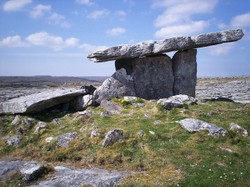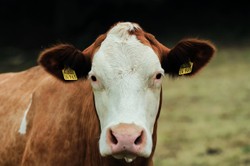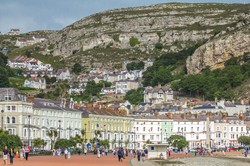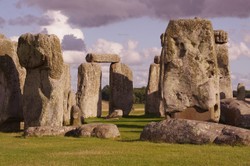Mallory makes the point that it is most likely that Ireland's Mesolithic settlers migrated via Britain, and he regards the relationship between the two islands as locked in a long-standing though often less than amicable relationship. He follows the norm for prehistorians in thinking that the Mesolithic inhabitants of both isles as having made little contribution to the genetics of Ireland, but he sees more contribution in the genetic history provided by the Neolithic farmers, who came to the British Isles from the Middle East bearing agriculture with them. It is these who made the great neolithic monuments of the two isles. Significant trade routes emerged and there was a common culture between Britain and Ireland, though in the later Neolithic some cultural divergences arose. Mallory does not analyse cultural divergences in detail, as he is more concerned with origins. However, he discusses the significance of the third group of incomers, the Beaker Folk, a group who introduced metallurgy and possibly brewing to the British Isles.
It is this group who were to give him the kind of bad luck that bedevils historical authors, for he concluded his work only for archaeologists discovered that the Beaker Folk, or a related culture, may have been the beneficiaries of a major pandemic, possibly Yersinia pestis, the Black Death, which swept through the British Isles subsequent to the construction of Stonehenge, possibly killing ninety per cent of the Neolithic inhabitants of Britain and eighty per cent of the Irish population. A hasty amendment had to be made to the book. Unlike the Neolithic folk, who were almost certainly brown, these folk originating in the steppes were white and they were responsible for the white skin of the British and Irish up to our time.
Mallory is luckier in his dealing with the Celtic Invasion, which did not happen. Nineteenth century historians postulated a Celtic invasion of Ireland to account for Celtic cultural elements in Irish art, but later scholars have replaced the invasion with cultural influences in the first century BC. The Irish were not ever a Celtic people, though there were probably cultural affinities with the Celtic tribes of Gall and Spain.
The book deals well with one puzzling element in the relationship between the two islands. Why were there on the East coast of Ireland a few tribes with British names, such as the Brigantes, a tribe from North East England corresponding to the Brigantes of South East Ireland. Mallory raises the issue in the context of political relationships in the British Isles in the pre-Roman period, but the issue is not resolved. He also relates this question to the issue of the languages spoken in Ireland.
One subject that Mallory deals with is the issue of the Romans in Ireland. There was a Roman presence in the isle, but it was not one of conquest, but rather of trade. The author does well to highlight this subject, which has hardly been a topic for popular history. It is known that Rome had cultural impact beyond its boundaries in states outside the empire, so it is not beyond belief that Roman cultural elements occur in Ireland.







 TheThousand Year Gardenon 11/26/2025
TheThousand Year Gardenon 11/26/2025
 Women of the Gospelson 10/11/2025
Women of the Gospelson 10/11/2025
 Religious Gardenson 08/25/2025
Religious Gardenson 08/25/2025
 Doctor of the Church: John Henry Newmanon 08/03/2025
Doctor of the Church: John Henry Newmanon 08/03/2025




Comments
I do not think that there is currently any difference between the diets.
The land and the sea animal populations of ancient and modern Ireland intrigue me.
Would you say that the northern and the republican Irish get their protein more from land or from sea life? In other words, would I find more land- or more sea-based protein sources if I would access northern and republican Irish recipes throughout time?
The land was short of animals for food, but the ocean was stocked with fish that swam where they chose.
The second paragraph to your first subheading, The Beginnings, considers that "The book pays serious attention to the initial stages of the peopling of the land and the establishment of its fauna. This is welcome because this issue is oft-neglected. The glaciers destroyed all life on the island, both animal and fish, meaning that the early settlers came to a land which was prone to famine."
Is the sea world around Ireland inhabited only by non-native fishes? If so, who might have introduced them from where?
The Tocharian and Gaelic languages belong to the Indo European group which originated in Anatolia, so there is ban affinity, but they do not have a specially definable connection.
I do not have access to the Barber book at this moment.
But my memory is that she listed among the mysteries of the light-eyed, light-skinned, slender, tall Urumchi mummies of the Tarim River Basin between India and China that they speak a language most related to the group to which Gaelic belongs even as they seem to have an ancient Iranian connection.
Would that suggest some predecessory kinship with the ancestors of the Irish or would it suggest that perhaps Tocharian was not their native language?
Horses are an Irish passion, but the geographical distance between the Irish and the
Tarim river people's implies a large difference in time between the contacts between the people's.I think that the Trojan connection is a red herring, as Trojans were not a distinct race or culture, they were a town in the broader cultural life of Anatolia that was destroyed.. no connections with Ireland can be discerned
Elizabeth Wayland Barber associates ancient Irish, Tarim River Basin peoples and Trojans with perfecters of horse-raising and textile-making, with residents near salt licks and with settlers of strategic sites with stunning views.
She identifies Tarim River Basin peoples, known as the Urumchi mummies, as speaking the Tocharian language, close to no language apart the group to which Gaelic belongs.
Would you say that her associations of horses, salt, sites and textiles apply to what we know to be true of the ancient Irish?
Your suggestion that a folk memory is augmented by subsequent memories is absolutely correct. Several different ones become fused into one single memory.
There is no memory of a giant flood in the British Isles, we had the story of Noah for that. Anyway, the story of Atlantis tells of a spectacular and unique event. However we have tales of localized flooding. There is a folk memory of flooding in Cardigan Bay which is supported by evidence from oceanography , and in Cornwalll legend speaks of the drowning of the land of Lyonesse
I like that suggestion of a folk memory.
Might there be a folk memory of such destruction in the British Isles or would such destruction be unthinkable in the context of how the waters around the British Isles behave?
Regarding Atlantis, would it be a case of one folk beginning that memory and others adding to it? Or would it be just the one memory and, if so, with what ancient country or ancient continental area?